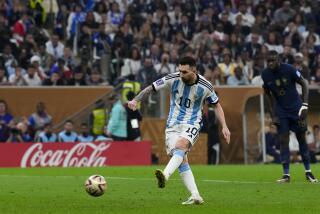Fashion Police States in Africa
- Share via
It seems that Emperor Akihito and Empress Michiko of Japan will be attending the World Cup final and closing ceremony on June 30 in Yokohama.
Knowing the predilection of emperors--in fable, if not in fact--one presumes the emperor will be wearing some clothes. It’s difficult to be certain, however, because dress is becoming quite the topic of debate as the World Cup approaches.
Take Nigeria, for instance. Last week fans of the Super Eagles were in an uproar over the new look of their national team--not the players who make up the team, but the jerseys those players wear.
Nigeria, which will play Argentina, Sweden and England in the first round, unveiled lemon-colored jerseys April 17 in a 2-1 win over Scotland. Fans loved the result but hated the jerseys.
“We are not aware of anything negative against the kits,” Nigeria Football Assn. marketing chief Edozie Enemuo told Agence France-Presse. “What we know is that they are of high quality and made of reflecting fabric to help the players cope with the heat.”
Unless Nigeria returns to its traditional green, it is the fans who are likely to turn up the heat.
Cameroon, meanwhile, has come up with a different solution. During the Indomitable Lions’ victorious march to the African Nations Cup title in Mali in February, Coach Winfried Schaefer’s squad sported something entirely new in soccer fashion: jerseys without sleeves and featuring a novel ventilation system that allowed fans more than a brief glimpse of the players’ torsos.
The basketball look drew a frown from FIFA’s World Cup Organizing Committee, which said that such attire would not be tolerated at Korea/Japan ’02.
Undeterred, Cameroon’s seamsters union went back to work and came up with another version that got a nod of approval from the FIFA fashion police.
“They have now come back with another design of their own, quite an ingenious one, which has been accepted,” said FIFA spokesman Keith Cooper.
Details of the new look, still featuring Cameroon’s bright green, red and yellow colors, are being kept secret, which is perhaps why Cameroon has chosen the remote town of Nakatsue, on the southern Japanese island of Kyushu, for its pre-World Cup training camp. Wild boar and raccoons are said to be more prevalent than people in the mountain redoubt.
Cameroon, the Olympic gold medalist in 2000 and African champion in 2002, plays Ireland, Saudi Arabia and Germany in the first round of the World Cup and has a good chance of advancing to the next round.
In its opening game against the Irish in Niigata, Japan, on June 1, it will be the Indomitable Lions’ uniforms, as much as their play, that will be the focus of attention.
While Cameroon is shedding clothing to beat the heat, England is heading in the opposite direction. Its players will be sporting jackets on the sideline, if not on the field.
Coach Sven-Goran Eriksson is from Sweden, so it’s not altogether surprising that England’s players will be told to don special sleeveless white jackets that have been soaked in water and frozen before use.
The jackets, developed by NASA and designed to help athletes sweat less and avoid dehydration, contain mysterious crystals that help maintain a constant low temperature for several hours.
“The ice jacket has been proved to help athletes handle the high temperatures out there [in Japan and Korea], and we are confident it will work,” Richard Hawkins, deputy head of the English Football Assn.’s Medical and Exercise Science Department, told England’s News of the World.
It was in Sweden, of course, that a 17-year-old by the name of Pele first grabbed the headlines, scoring two goals against Sweden in the final to help Brazil win the 1958 World Cup.
Ever since, Pele jerseys have been gold, and not just in color. Last week, their value again was underlined when a financially hard-pressed amateur club in Chile decided to put its most valuable asset up for auction.
According to a report from Reuters, Deportivo Monjas has “kept the treasure, unwashed and in a glass frame, at their clubhouse--a rundown wooden hut on a hill overlooking the Pacific Ocean in the gritty port city of Valparaiso,” for the better part of 40 years.
It is a shirt worn by Pele when he helped Santos win its third Brazilian championship in a row in 1962. How Deportivo Monjas acquired it is a tale in itself.
As the story goes, Andres Urrejola--now 61 and living in Brazil--was a Chilean student who attended Santos’ game against Sao Paulo at Pacaembu Stadium four decades ago. At the final whistle, he ran onto the field and virtually wrestled the jersey off Pele.
The escapade was featured in a Brazilian newspaper, and afterward Urrejola donated the jersey to Deportivo Monjas, his favorite team.
The club finds itself strapped for cash and has put Pele’s jersey, now a faded white with the famous No. 10 sewn in black on the back, up for bid on a Latin American Internet auction site, www.deremate.com.
Bids started at $30,000, and the auction runs through Saturday. “If we get $60,000 or even $70,000, we will be happy,” club spokesman Marcelo Hernandez told Reuters.
Only last month, a shirt worn by Pele during Brazil’s victory over Italy in the 1970 World Cup final in Mexico fetched a record $224,600 at Christie’s auction house in London. It was sold to an anonymous phone bidder.
The previous record for a soccer jersey was $146,800, paid for one that belonged to Geoff Hurst, who scored a hat trick in England’s 1966 World Cup final victory over West Germany.
Whoever scores the winning goal at this year’s final in Yokohama could find himself with some valuable threads. Of course, it’s not the clothes you wear, it’s who wears them.
Even Emperor Akihito could tell you that.
*
(BEGIN TEXT OF INFOBOX)
FIFA Rankings
(text of infobox not included)
More to Read
Go beyond the scoreboard
Get the latest on L.A.'s teams in the daily Sports Report newsletter.
You may occasionally receive promotional content from the Los Angeles Times.








